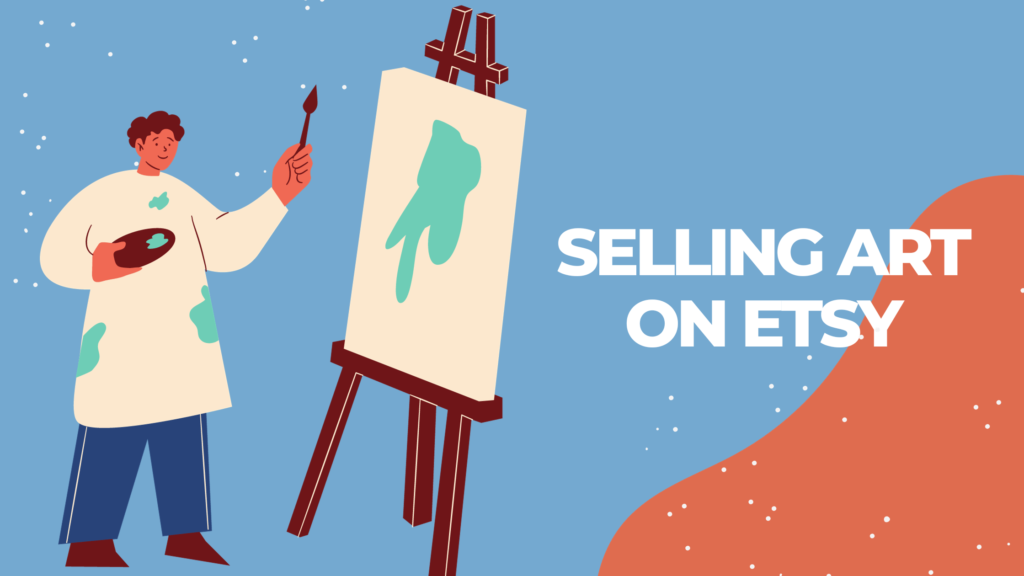If you’re an artist looking to sell your creations online, Etsy can be your ideal platform. With a vast global community of art enthusiasts and a penchant for unique, handmade items, it’s a perfect match. In this guide, we’ll walk you through the process of selling your art on Etsy, from setting up your shop to marketing your products effectively. Whether you’re seeking inspiration to continue your artistic journey or aiming to generate income online, read on for valuable tips.
Creating Your Etsy Shop and Finding Your Niche
Launching your Etsy shop is a straightforward process, but success in this bustling marketplace requires dedication and strategic thinking. Let’s begin with the first step:
1. Create an Etsy Account
Begin by setting up your shop on Etsy. It’s a simple process. Visit Etsy’s website and create an account, or sign up using your Google or Facebook credentials. You’ll need to specify your shop’s location and preferred currency. Afterward, choose a unique shop name, create your first listing, and set up payment methods.
2. Define Your Target Audience and Research the Competition
To maximize your chances of success, tailor your offerings to a specific target audience. Consider factors such as age, location, interests, and buying habits. For instance, if you create abstract minimalist paintings, you might want to target a younger audience in urban areas interested in contemporary art and interior design.
Research similar products and identify gaps in the market. Observe how other artists on Etsy and other online marketplaces sell their art and identify popular themes, styles, and price points. Understanding your competition can help you differentiate your shop and make it more appealing to your target audience.
Deciding on Your Products
Diversify your product offerings to stand out in the crowded art market on Etsy. Instead of thinking of your items as individual pieces, consider them as part of a complementary range. This approach can attract a wider audience and foster repeat customers who love your style.
– Original Artwork
Etsy is an excellent platform for selling handmade original artwork. Showcase your creative process by sharing images of your studio work, including the printing process, paint application, and close-up details. This transparency allows potential buyers to see the unique qualities of each piece.
– Posters
Many Etsy shoppers are looking for affordable decor items like posters to enhance their living or office spaces. Selling prints of your art can be profitable, as you can generate repeat income from a single piece. Additionally, offering lower-priced items compared to original art can lead to higher sales volume.
Explore print-on-demand services to create posters with your artwork, even if you don’t have your own printing equipment. Giclée printing, in particular, produces high-quality digital reproductions of your art that are durable and cost-effective.
– Canvas
Printing your designs on canvas adds sophistication and a trendy, artsy touch to your art. This option is ideal for photographers or digital artists creating colorful and bold images. Canvas wall art is a statement piece found in many homes.
– Postcards
Consider selling popular designs as postcards or add-ons to other purchases once you identify your best-selling designs. Handwritten notes and greeting cards enthusiasts will appreciate having original postcards.
– Stickers
Stickers are versatile products that allow you to experiment with custom shapes, colors, and text. Made from durable vinyl, they appeal to customers looking for smaller purchases before committing to larger canvases.
– Mugs
Mugs are personal items and popular gifts for hot beverage lovers. Adding your artwork to coffee mugs can attract customers seeking unique designs for their morning routines.
– Apparel
T-shirts and hoodies are wardrobe staples that art enthusiasts are eager to adorn with original designs. Consider selling uniquely-designed apparel to stand out in this market.
– Accessories
Etsy’s accessory market is substantial, making it a great opportunity to place your design on items like phone cases. Shoppers often seek distinctive, eye-catching designs for their phone accessories.
Perfecting Your Etsy Listings
In a competitive Etsy marketplace, optimizing your listings is essential for success. To increase visibility and attract potential buyers, pay attention to your product imagery, descriptions, and keywords.
– Title
Craft descriptive titles that incorporate keywords relevant to your product. For instance, if you’re selling an art print, use keywords like “art print,” “home decor,” “wall art,” or similar terms that potential buyers might use in their search.
– Description
Incorporate descriptive keywords throughout your listing descriptions, tags, categories, and attributes. This optimization is crucial for Etsy SEO and ensuring your products are discoverable. Avoid listing keywords in a row; instead, create a connection with your art by crafting engaging descriptions that highlight your materials, size, technique, packaging, and unique details.
– Product Photos
High-quality images are crucial on Etsy, as they are the first thing potential buyers notice. Ensure your product photos are well-lit, in focus, and set against a clear background. Visual cues, such as showing your artwork in a home interior setting, can help buyers envision how it fits into their decor.
– Videos
Including videos with your listings can capture buyers’ attention and engage them longer. High-resolution videos that zoom in on important details provide a better sense of color, texture, and dimensions. Etsy’s search algorithm favors listings with multiple photos and videos, increasing their visibility.
– Tags
Tags play a crucial role in Etsy SEO by helping buyers discover similar products. You can add up to 13 tags for each listing, so select descriptive and popular keywords relevant to your target audience. Ensure your tags cover various aspects of your piece, such as material, size, technique, subject, and use.
Marketing Your Etsy Store
To boost your Etsy sales, leverage the platform’s built-in marketing tools and optimize your listings using Etsy SEO. Additionally, create art-related content on social media platforms to showcase your work, build a loyal customer base, and expand your audience.
– Etsy Ads
Consider using Etsy Ads (promoted listings) to appear at the top of search results. Set a budget and choose which listings to boost. You’ll be charged when someone makes a purchase, making it more cost-effective for higher-priced items. Monitor and adjust your ad campaign based on data to refine your marketing strategy.
– Etsy SEO
Etsy offers a range of SEO tools, including the search bar, related items section, and shop sections feature. Understand how Etsy SEO works by researching and using relevant keywords in your product titles, tags, and descriptions. Staying updated with SEO best practices and algorithm updates is crucial for long-term success.
– Social Media
Share images and videos of your artwork on platforms like Instagram and TikTok to connect with a global audience. Engage with your audience by creating captivating content about your art. Social media can help you gain exposure and attract more customers.
Is Etsy a Good Place to Sell Art?
Etsy offers numerous benefits for artists, including a global audience, ease of setup, and the potential for higher profits compared to traditional gallery sales. However, it’s important to note that Etsy is highly competitive, and standing out requires time, effort, and effective marketing strategies.
Pricing Your Art to Sell on Etsy
When determining your pricing strategy, consider factors like materials, time invested, and your experience. Keep in mind that Etsy charges fees for listing items and processing transactions, so factor these costs into your pricing.
Offer different sizes and price points to attract a variety of customers. Use your original artwork as higher-end options, while prints and other products can cater to different budgets. Periodically check competitors’ prices and adjust your listings to remain competitive.
Conclusion
To succeed in selling art on Etsy, embrace your unique style and cultivate a dedicated following around it. Focus on optimizing your listings using Etsy SEO and create engaging content about your art on social media. Research your target audience and offer a diverse range of products to fill market gaps. Success on Etsy requires dedication to marketing your art, building a strong brand, and providing top-notch customer service.



